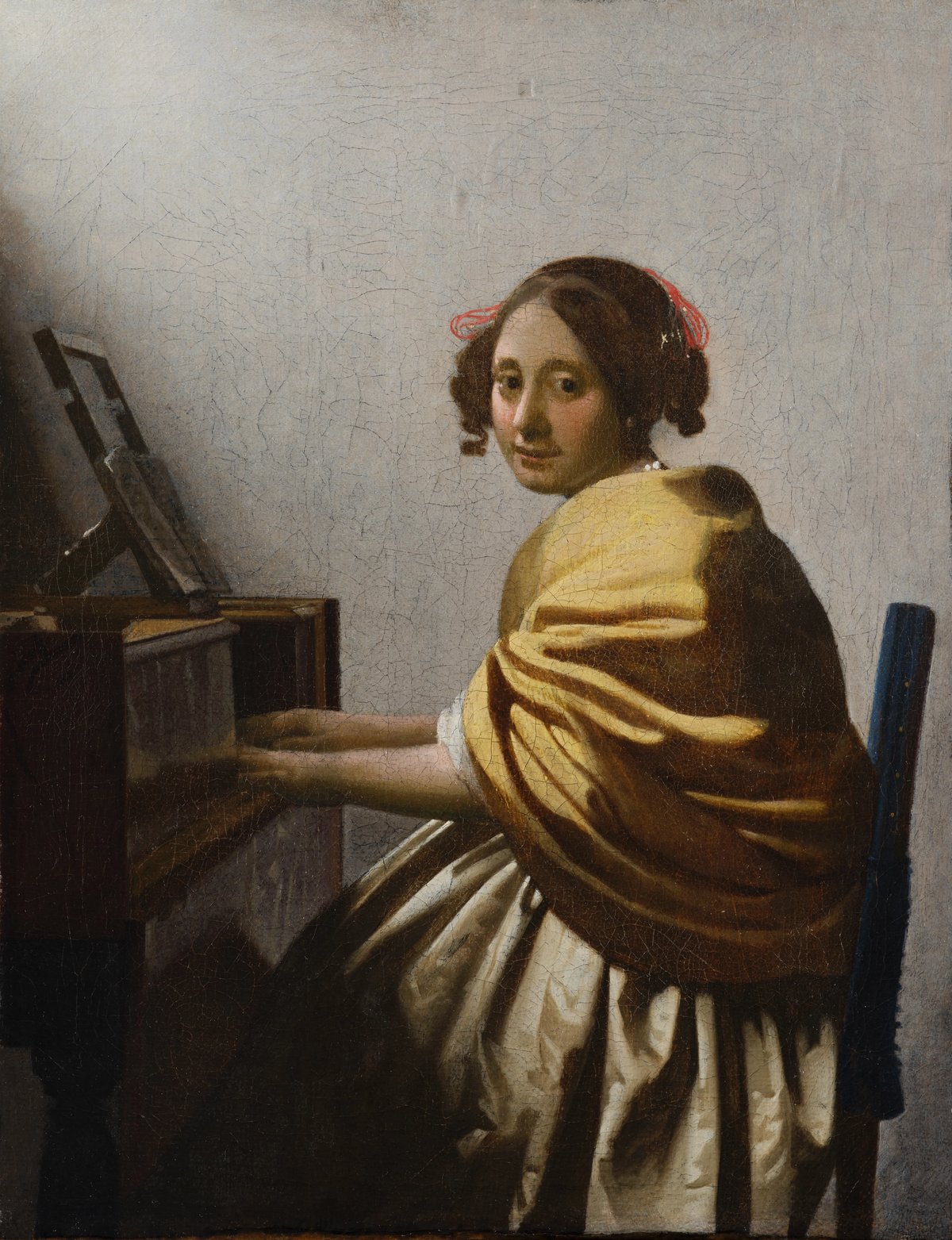The newly “rediscovered” Vermeer of a Young woman at a virginal has gone on show in London, at the National Gallery’s Vermeer and the Delft School exhibition. This is the first time that the work has been publicly exhibited in Europe since 1907.
Owned by the Belgian collector Baron Frederick Rolin, the picture was a last-minute addition to the exhibition at its earlier venue, the Metropolitan Museum in New York.
The National Gallery curator Axel Rüger admits that Young woman at a virginal is a puzzle. “There are passages I find compelling, such as the way the skirt is painted and the reflection in the instrument, which are close to the Woman standing at the virginal in the National Gallery.” But he feels that other parts are less skilfully handled and “the scale of the picture and the small field seem rather unusual for Vermeer.”
Technical evidence, which The Art Newspaper exclusively reported, proves that the controversial painting dates from Vermeer’s time and therefore is by Vermeer or by one of his contemporaries.
Rüger admits that “we do not know of any pupils or followers of Vermeer from his period”. To accept the existence of a previously unknown follower would therefore change our perception of Vermeer, who is not thought to have had a studio with assistants. Instead he has been seen as an isolated artist, working away meticulously on his own.
One possibility which is tentatively suggested by Rüger is that Young woman at a virginal could be one of Vermeer’s final works, which remained uncompleted on his death in 1675. The yellow of the dress has two layers and was repainted much less skilfully; this appears to have been done soon after the original painting was done. “Possibly the picture was left in Vermeer’s studio after his death and finished by someone else,” Rüger suggested.
Young woman at a virginal was purchased by the mining magnate Alfred Beit in the 1890s (it may also have been the picture recorded in the Wessel Reyers auction in Amsterdam in 1814 which was later sold to the dealer Gruyter). The painting passed to Alfred’s brother, Sir Otto, and then to Sir Alfred, who sold it in 1960. It went through Marlborough Fine Art to Baron Rolin.
The painting’s early history remains obscure, but either the Rolin picture or one of the two London Vermeers was presumably the Young lady playing the spinet recorded in a 1696 sale in Amsterdam. The European unveiling of the Rolin painting will only add to public interest in the Vermeer and the Delft School exhibition, which was already expected to be a blockbuster. By the time the show closed in New York, on 27 May, it had been seen by 545,000 visitors.
New light on the London Vermeers
If the Rolin Young woman at a virginal is finally accepted as authentic, scholars will have to reconsider whether the two Vermeers in London’s National Gallery were produced as pendants. For many years the gallery has taken the position that its Young woman standing at a virginal and Young woman seated at a virginal were created as separate works. This was partly on the grounds that a single Vermeer described as “a playing lady on the harpsichord” was recorded in the Dissius sale of 1696, which it was assumed was one of the National Gallery’s pictures.
However if authenticated, the Rolin painting is arguably more likely to be the one recorded in this sale (the price, 42 guilders, would have been low for one of the National Gallery works, which are larger and more elaborate). Liedtke himself accepts that for a number of reasons the two London pictures are indeed pendants, dating to 1670-72, which became separated and then providentially ended up together centuries later.
The expert opinions on the Vermeer
Since Young woman at a virginal was unveiled in New York, American specialists have been more enthusiastic than their Dutch colleagues.
Walter Liedtke, a curator at the Metropolitan Museum, New York and a selector of the current exhibition. He believes it is a work of Vermeer’s period, that it is very close to his style and technique, and that as far as we know the artist had no studio or followers.
Arthur Wheelock the organiser of the 1995-96 Vermeer exhibition and a curator at the National Gallery of Art, Washington. She is “open minded” about its authenticity,although he is now looking on it increasingly favourably. “Portions of the picture are very similar to what Vermeer does.”
Frits Duparc, the director of the the Mauritshuis, The Hague Based on an examination of a photograph, he feels “the quality of the Rolin picture is weak, and I cannot believe it is a Vermeer”. He accepts, however, that it may well be late 17th century, and “inspired by Vermeer’s work.”
Ben Broos, research curatorMauritshuisDismisses it in stronger terms,and hasdescribed it as a “tasteless mishmash of the two women playing virginals in the National Gallery in London”. He has even suggested that it dates from the 1930s, when the notorious forger Hans van Meegeren was at work (however, this dating cannot be correct, since the painting has been fully documented since the 1890s).
Albert Blankert, Vermeer specialist More measured in his comments, although he too dismisses the picture. “It has elements taken from Vermeer’s pictures, but the anatomy of the woman is wrong and the hands look more like pigs’ trotters. It is an imitation.”
Gregory Rubinstein, Sotheby’s, advising to Baron Rolin Points out that until now the painting was only known from poor reproductions, which do not show the extent of later overpaint. The red ribbons in the woman’s hair, for instance, were added in the 1950s, although there are traces of original red below, and there has also been retouching to the face. The painting could eventually be auctioned by Sotheby’s, but Baron Rolin has not yet been made a decision.



